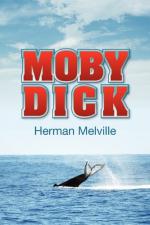The entire member seems a dense webbed bed of welded sinews; but cut into it, and you find that three distinct strata compose it:—upper, middle, and lower. The fibres in the upper and lower layers, are long and horizontal; those of the middle one, very short, and running crosswise between the outside layers. This triune structure, as much as anything else, imparts power to the tail. To the student of old Roman walls, the middle layer will furnish a curious parallel to the thin course of tiles always alternating with the stone in those wonderful relics of the antique, and which undoubtedly contribute so much to the great strength of the masonry.
But as if this vast local power in the tendinous tail were not enough, the whole bulk of the leviathan is knit over with a warp and woof of muscular fibres and filaments, which passing on either side the loins and running down into the flukes, insensibly blend with them, and largely contribute to their might; so that in the tail the confluent measureless force of the whole whale seems concentrated to a point. Could annihilation occur to matter, this were the thing to do it.
Nor does this—its amazing strength, at all tend to cripple the graceful flexion of its motions; where infantileness of ease undulates through a Titanism of power. On the contrary, those motions derive their most appalling beauty from it. Real strength never impairs beauty or harmony, but it often bestows it; and in everything imposingly beautiful, strength has much to do with the magic. Take away the tied tendons that all over seem bursting from the marble in the carved Hercules, and its charm would be gone. As devout Eckerman lifted the linen sheet from the naked corpse of Goethe, he was overwhelmed with the massive chest of the man, that seemed as a Roman triumphal arch. When Angelo paints even God the Father in human form, mark what robustness is there. And whatever they may reveal of the divine love in the Son, the soft, curled, hermaphroditical Italian pictures, in which his idea has been most successfully embodied; these pictures, so destitute as they are of all brawniness, hint nothing of any power, but the mere negative, feminine one of submission and endurance, which on all hands it is conceded, form the peculiar practical virtues of his teachings.
Such is the subtle elasticity of the organ I treat of, that whether wielded in sport, or in earnest, or in anger, whatever be the mood it be in, its flexions are invariably marked by exceeding grace. Therein no fairy’s arm can transcend it.
Five great motions are peculiar to it. First, when used as a fin for progression; Second, when used as a mace in battle; Third, in sweeping; Fourth, in lobtailing; Fifth, in peaking flukes.
First: Being horizontal in its position, the Leviathan’s tail acts in a different manner from the tails of all other sea creatures. It never wriggles. In man or fish, wriggling is a sign of inferiority. To the whale his tail is the sole means of propulsion. Scroll-wise coiled forwards beneath the body, and then rapidly sprung backwards, it is this which gives that singular darting, leaping motion to the monster when furiously swimming. His side-fins only serve to steer by.




